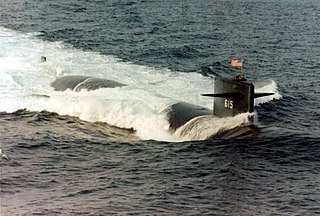
USS Gato (SSN-615) was a Thresher/Permit-class nuclear submarine known as the "Goal Keeper" or the "Black Cat." She was the second United States Navy ship named after the gato, a species of small catshark found in waters along the west coast of Mexico.

USS Dace (SSN-607), a Permit-class submarine, was the second ship of the United States Navy to be named for the dace, any of several small North American fresh-water fishes of the carp family. The contract to build her was awarded to Ingalls Shipbuilding in Pascagoula, Mississippi on 3 March 1959 and her keel was laid down on 6 June 1960. She was launched on 18 August 1962, sponsored by Betty Ford, wife of future President of the United States Gerald R. Ford, Jr., and commissioned on 4 April 1964, with Commander John A. Walsh in command.

USS Marlin (SST-2), originally USS T-2 (SST-2), was a T-1-class training submarine in commission from 1953 to 1973. She was the second submarine of the United States Navy to be named for the marlin, a large game fish. Except for the first 25 early development pre-WWI subs, she was one of the smallest operational submarines ever built for the U.S. Navy.

USS Hawkbill (SSN-666), a Sturgeon-class attack submarine, was the second ship of the United States Navy to be named for the hawksbill, a large sea turtle. The name perpetuated the inadvertent misspelling of "hawksbill" in the naming of the first ship of that name, USS Hawkbill (SS-366), a Balao-class submarine launched in 1944. USS Hawkbill (SSN-666) was the eighteenth of 39 Sturgeon-class nuclear-powered submarines that were built.
USS Grayling has been the name of more than one United States Navy ship, and may refer to:
USS Finback (SS-230), a Gato-class submarine was the first ship of the United States Navy to be named for the finback.

USS Finback (SSN-670), a Sturgeon-class attack submarine, was the second ship of the United States Navy to be named for the finback, the common whale of the Atlantic coast of the United States.

USS Billfish (SSN-676), a Sturgeon-class attack submarine, was the second ship of the United States Navy to be named for the billfish, a name used for any fish, such as gar or spearfish, with bill-shaped jaws.

USS Baltimore (SSN-704), a Los Angeles-class submarine, was the sixth ship of the United States Navy to be named for Baltimore, Maryland. The contract to build her was awarded to the Electric Boat Division of General Dynamics Corporation in Groton, Connecticut on 31 October 1973 and her keel was laid down on 21 May 1979. She was launched on 13 December 1980 sponsored by Congresswoman Marjorie S. Holt, and commissioned on 24 July 1982 with Captain Michael D. Bradley in command. The vessel's logo was "From Sails to Atoms," as inscribed on the ships original plaque.

USS Bream (SS/SSK/AGSS-243), a Gato-class submarine, was the first ship of the United States Navy to be named for the bream.
Two ships of the United States Navy have borne the name USS Perch, named in honor of the perch, a type of fresh-water spiny-finned fish belonging to the family Percidae.

USS Hazard (AM-240) was an Admirable-class minesweeper that served in the United States Navy during World War II.
Two ships of the United States Navy have borne the name USS Permit, named in honor of the permit, a food fish, often called "round pompano", found in waters from North Carolina to Brazil.
Three ships of the United States Navy have borne the name USS Sculpin, named in honor of the sculpin.
Two ships of the United States Navy have borne the name USS Gudgeon, named in honor of the gudgeon.
Two ships of the United States Navy have borne the name USS Trigger, named in honor of the triggerfish, any of numerous deep-bodied fishes of warm seas having an anterior dorsal fin with two or three stout erectile spines.
Imperial Japanese Navy submarines originated with the purchase of five Holland type submarines from the United States in 1904. Japanese submarine forces progressively built up strength and expertise, becoming by the beginning of World War II one of the world's most varied and powerful submarine fleets.

USS Bray (DE-709) was a Rudderow-class destroyer escort in service with the United States Navy from 1944 to 1946. She was sunk as a target in 1963.

The Bronstein-class frigates were United States Navy warships, originally laid down as ocean escorts, but were all redesignated as frigates on 30 June 1975 in the United States Navy 1975 ship reclassification and their hull designation changed from DE to FF.
This page is based on this
Wikipedia article Text is available under the
CC BY-SA 4.0 license; additional terms may apply.
Images, videos and audio are available under their respective licenses.










